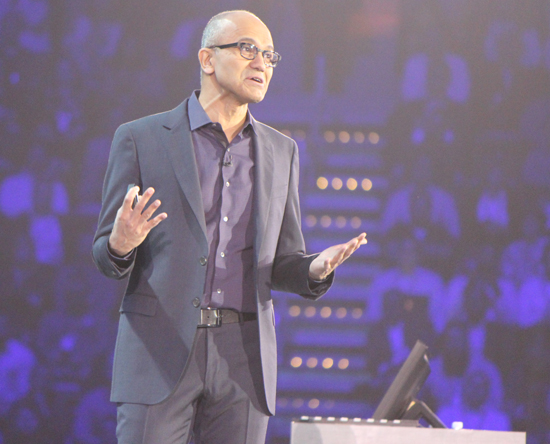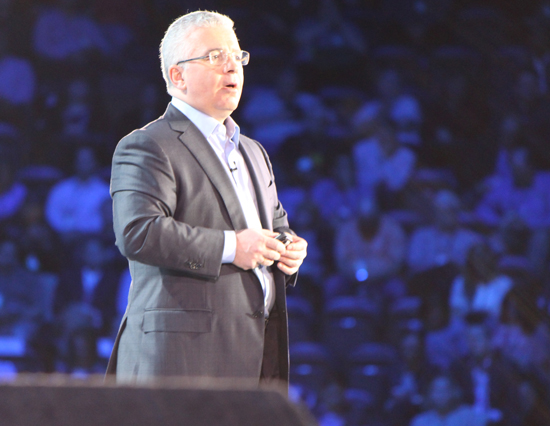Atlanta – Microsoft Corp. pitched its software solutions and cloud offerings for business on the strength of its experience making consumer products, as it announced a slew of dates to core enterprise products including Dynamics, Office, Skype, and Azure.
Addressing a packed sports stadium at Microsoft Convergence, the Redmond vendor’s annual conference for its business customers and partners, CEO Satya Nadella painted a picture of sea change for organizations in the digital age. He alluded to how the mainframe era saw the beginning of computers put to use in business, then the extension of computing throughout the enterprise thanks to the client-server model of delivery. But cloud computing is changing the game again.
“We’re at the dawn of a new era in business systems. We can now build these systems of intelligence,” he said. “These systems of intelligence don’t sit in isolation, they in fact build on the entire digital record we have with the systems of engagement and create one feedback loop.”

Microsoft CEO Satya Nadella says Microsoft is in the ’empowerment business.’
Before listing off the product announcements in store for the keynote, Nadella framed Microsoft’s identity as a company.
“It is about empowering you as individuals and organizations. To be able to drive your agenda and succeed in your business,” he said. “We are in the empowerment business.”
Microsoft’s partner community has a role to play in educating businesses about the slew of new products Microsoft is offering and the organizational change needed to take full advantage of them, says Natalie Petouhoff, vice-president and principal analyst at Constellation Research. While the tools may be there and Microsoft is certainly ready to help deliver them, the biggest bottleneck in realizing Nadella’s vision may lie in training.
“There’s a shortage of people with the skills to use this software,” she says. “There’s this disruption happening in the digital process. But it always comes down to people. It’s always been true and it always will be true. You can have the best software on the planet, if people don’t use it, it doesn’t matter.”
For Michael Kulik, president of Markham, Ont.-based independent software vendor Digital Vantage Point, Microsoft’s new open approach under Nadella is helping make education a more achievable goal. Most discussions with a customer involve about the Dynamics NAV implementations his firm does involve the topic of where to store their data, and now more options can be put forward.
“Now we can add do that, do you want to host this with Microsoft?” he explains. “Having a partnership where our technology is hosted inside Microsoft’s trusted environment is helpful.”
After Nadella set up Microsoft as the company that could deliver consumer-style apps that are enterprise-ready, a demo was done showcasing Microsoft’s new suite of products, involving many solutions that could be purchased directly or subscribed via the cloud.
But Kirill Tatarinov, executive vice-president of business services at Microsoft, said in a follow up briefing that the demonstration was no slight to the channel. He also put out a call for more partner help on selling Microsoft’s Dynamics line of products.
“There’s a partner behind each one of those success stories,” he said of the examples raised during the keynote. “There’s a tremendous effort underway to train Office 365 partners on Dynamics.”
That’s what’s needed if Microsoft is to help its customers meet expectations, he added.
“Ultimately the customer is viewed at the central part of every business,” he said. “We must treat the customer as if they are part of our organization, that is what’s expected.”

Kirill Tartarinov, EVP of business services at Microsoft, says proactive service is what the world demands today.
Microsoft has 15 years of experience when it comes to implementing back office solutions, and along with its partners are ready to help customers reinvent back-office processes. He described the roles of CIO and marketer as moving closer together – while CIOs are helping businesses adopt technology, marketers are also often enabling everyone within their company with the means to advance their brand.
“This is all about delivering visible and measurable outcomes and being able to demonstrate impacts,” he said.
Here’s an overview of the product announcements out of Microsoft Convergence thus far:
- Microsoft Azure IoT Suite is a platform offered up to companies that need to build their own software applications so their employees can better run their business. Coming out in a preview later this year, it will offer finished applications for scenarios such as remote monitoring, asset management and predictive maintenance.
- Windows 10 for IoT will offer universal applications and driver models for gateways to ATM machines.
- Power BI is now available worldwide as a part of Office 365. Its users can visualize business data with interactive dashboards and share their findings with colleagues. New Power BI connectors for data sources including Google Analytics, Twilio, and Dynamics Marketing will be available soon.
- The spring release for Dynamics CRM is expected by the end of the second quarter. It will contain more connections to Office 365, introduce Microsoft Social Engagement, a social monitoring tool.
- Office Delve is a news feed for your Office documents. Nadella demonstrated it on stage, describing it as a Facebook-like view of your work day.
- Office 2016 is coming out soon, and the technical preview of the desktop software is now available. The software is expected for release in the second half of this year.
- Skype for Business was launched, replacing Microsoft Lync. The technical preview is now available and a new client, plus Office 365 access will be available in April.



